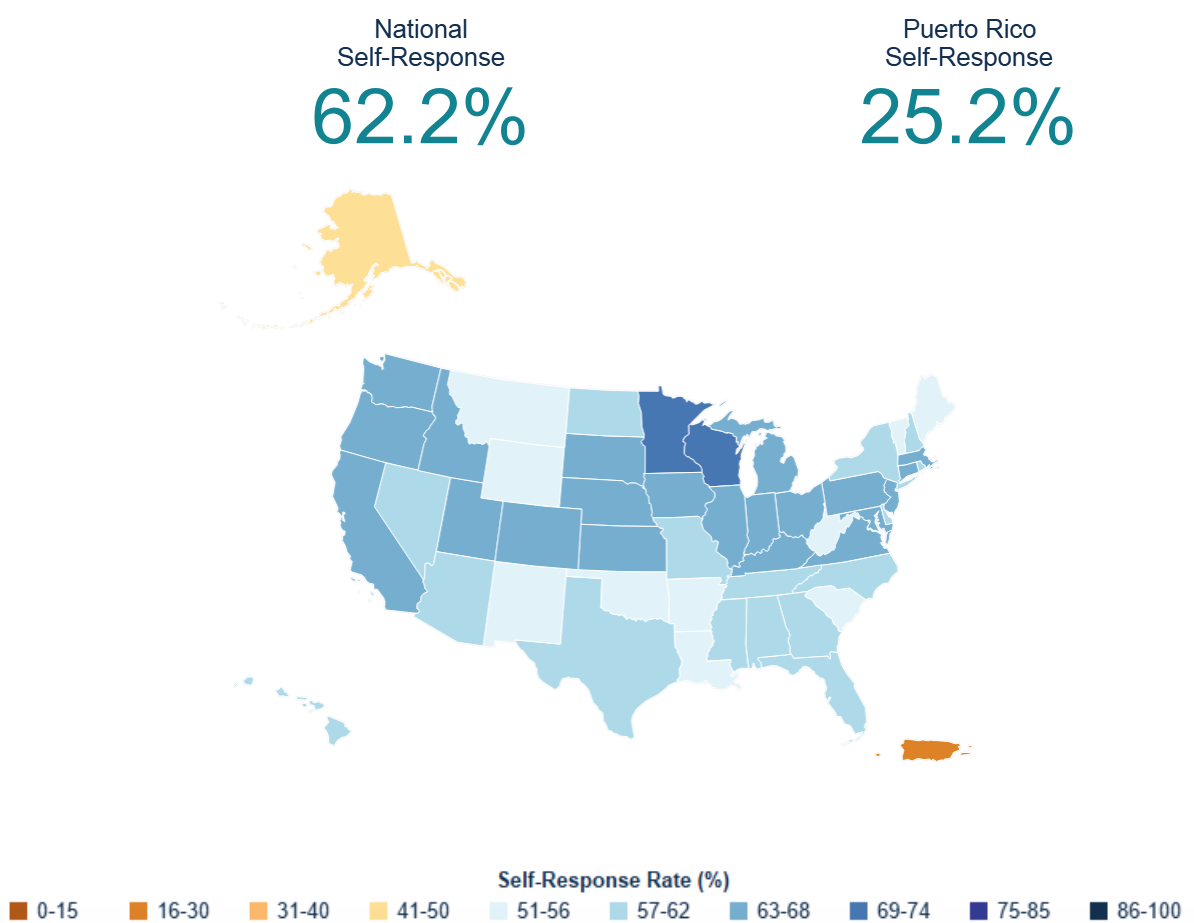WASHINGTON, D.C. — With just over three months to go in the self-response period, the Latino response rate for the 2020 Census is dragging.
While there’s still time for a turnaround, an undercount of Latinos in the U.S. could have an eventual impact on health or education, during a time where they are among the most dramatically affected by the coronavirus pandemic and accompanying recession.
The National Association of Latino Elected and Appointed Officials (NALEO) Educational Fund, which has been tracking Census response rates in areas with large concentrations of Latinos, found that “on average, the higher the Latino share of a county’s population, the lower its self-response rate,” Dorian Caal, director of civic engagement research at NALEO told Latino Rebels.
NALEO’s internal analysis found that counties with majority Latino populations have significantly lower response rates so far than those counties where less than 20 percent of people are Latino. Puerto Rico in particular has a response rate that’s extremely low.
The Census count has huge practical effects for everyday life. Its results determine how many elected officials states get in the House of Representatives, as well as how more than $675 billion in federal funding is split up. Depending on the number and demographics of people living in a state, county or even a smaller area, money is given for schools, healthcare, and infrastructure.
Latino communities are in dire need of this money as it stands. Black and Latino individuals currently have a 15 percent unemployment rate, while the white unemployment rate is down to nine percent. In New York City alone, half of immigrant workers are unemployed due to the pandemic.
Latinos are also far outpacing other groups when it comes to rates of coronavirus infection. Meanwhile, they continue to have the highest uninsured rate of any group, more than three times that of white Americans. The census determines funding for things like Medicare, Medicaid, food stamps, Pell Grants for students, and Section 8 vouchers, all of which are lifelines during an economic downturn.
In Puerto Rico, where coronavirus cases are up more than 200 percent over the past two weeks, and less than 25 percent of residents have responded to the Census, governor Wanda Vázquez recently released a statement urging Puerto Ricans to complete the task.
“As we continue to combat COVID-19 and move forward with the reopening of our economy, it is important that we focus on responding to the 2020 Census,” Vázquez said in the statement.


The current national self-response rate and Puerto Rico’s self-response rate as of July 20 (Sources: U.S. Census Bureau)
The island has faced economic, political, environmental crises over the past few years, and the federal government has been reluctant to deliver the aid necessary to assist the struggling territory.
“If underreporting happens on the island, this will create a domino effect on the amount of federal funding the island receives,” said Executive Director of the Puerto Rico Federal Affairs Administration (PRFAA) Jennifer M. Storipan.
“Absolutely the biggest challenge we had in Puerto Rico is this COVID-19,” Jeff Behler, the Census official who oversees data collection in Puerto Rico and eight states in the Northeast, told Latino Rebels.
In the aftermath of Hurricane María, the addresses of homes in Puerto Rico didn’t match what the Census had in its database. So instead of mailing forms to each home, as the bureau does in most of the U.S., they decided to hand-deliver forms to each home in-person.
“We started that operation on March 15,” Behler said. “We suspended that operation on March 17.” Census workers only were able to distribute forms to two percent of addresses on the island, and so most people didn’t get a reminder. Workers just restarted that effort at the end of June.
“We’re really boosting up our advertising down there, now that everyone has received their invitation packet. We’re hopeful before we start knocking on doors, we can increase that self-response rate,” Behler said.
An undercount wouldn’t be unusual for Latinos across the U.S. In fact, “these are the people that have largely been undercounted in the past,” said Rogelio Sáenz, the Dean of the College of Public Policy at the University of Texas at San Antonio.
“Latinos, African Americans, Native Americans, the poor, obviously, the homeless, children… [and] students,” are all groups that struggle to be fully counted in census after census, said Sáenz, who is also a frequent contributor to Latino Rebels.
Because those groups have been difficult to count accurately, some state and local governments put extra resources and messaging towards getting the word out to them.
Nearly two dozen states, including California, New York, and Illinois have put aside more than a million dollars to ensure they get a complete count of the people there.
“I think another thing that has been missing [this time] is that you’ve had government leaders. reassuring presidents, for example, who were reassuring people that their answers will not be shared with the Department of Homeland Security in the past, with the Immigration Naturalization Service,” Sáenz said. “Of course, we haven’t seen that maybe with the Trump administration.”
The increased local funding for the Census effort is a reaction to the Trump administration’s efforts to put a citizenship question on the 2020 edition, a goal that they did not achieve. Yet the aftereffects of those efforts have caused problems among Latinos and other immigrant groups.
Groups like NALEO and Spanish-language outlets like Telemundo have been doing outreach in order to combat the fear or lack of knowledge Latinos have about the census.
During a live-stream event held in Spanish, Adán Chávez, Deputy Director of the National Census Program at NALEO, reminded listeners, “For Latinos, the Census is an opportunity to say we are here, we work here, and we’re going to make ourselves count here.”
***
Ana Lucía Murillo is a journalist based in Washington, D.C. and the 2020 summer correspondent for Latino Rebels. She tweets from @analuciamur.



